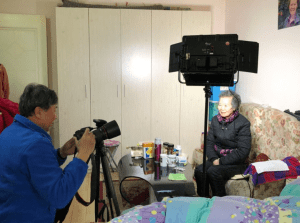On ageing, migrants, and cremation: a moving burial for moving people
By Alfonso Otaegui, on 11 December 2020

Figure 1. Young man during a procession of El Señor de los Milagros in Arequipa, Peru. CCNC-BY Alfonso Otaegui
I did fieldwork among Peruvian migrants in Santiago, Chile, focusing on their experience of ageing as migrants. When talking about life in general, their stories of struggle and success, and their aspirations towards the future, conversations always turn to discussing what will happen when they will no longer be here: legacies that may or may not be passed onto the next generation, their children and their future and even what will happen to their own bodies.
I must highlight that I did fieldwork within a Christian brotherhood that honours a Peruvian patron saint, El Señor de los Milagros. Therefore, what is discussed in these paragraphs does not apply to all Peruvian migrants in Chile[i] The fact that the research participants are devout Christians, however, makes some findings more intriguing.
Burial is traditional among Catholics and, therefore, also among the participants of the study[ii]. Several of them recall going to the cemetery in Peru to honour their grandparents or even family members they had never met. Most of them, however, have come to the idea –some of them just recently, others before– that they would prefer to be cremated. In a way, this is a sacrifice that they are making for the sake of their children.
Throughout the conversations with the migrants who prefer cremation as a way of disposing of their bodies, two major explanations seem to appear. The first one is rather technical and pragmatic. If a migrant passes away in the destination country and wants to be buried in Peru, this presents many difficulties. Liliana, a 62-year-old accountant, recalls the story of her sister, who passed away in the United States. The bureaucracy of moving the body of a deceased person to another country was a nightmare, so finally, she decided that she should be laid to rest in the US. Repatriation would also have been extremely expensive. The other reason why one may prefer cremation can be attributed to changes in traditions. José, a 61-year-old lawyer, acknowledges this, in a tone that contains resignation and hints of nostalgia: ‘families used to go to the cemetery to put flowers on their dead ones…but that has been lost, they start to forget you…what would be the point [of a burial]? Even I go to the cemetery less often when I visit Peru’. José acknowledges that people tend to go to the cemetery less and accepts it as a natural change that comes with the new generations: some customs just get lost. He is starting to consider cremation, so if his children want to spread his ashes, they can do it. It seems that he wants to release his children from the duty of going to the cemetery. Elena, a 48-year-old nurse, is quite straightforward about this point: ‘cremation. It is the most pragmatic for my daughters, so they can forget about going to the cemetery and laying down flowers’.
There is a sense of not being a burden to their children, coupled with the acceptance that their children will not continue these traditions. There is also something about cremation and the portability of funeral urns that make this method especially suitable for these migrants: a moving burial for moving people. The story of Marcos, 56 years old, illustrates this point. Marcos has his mother and his father in Peru. He also has two daughters from his first marriage scattered across the two countries – one in Peru, the other one in Chile. His second and current wife and their son live in Chile. When talking about the future, the possibility of death and what happens afterwards, he states quite firmly: ‘Cremated. Half of me will be here, and the other half will be there’. His firm decision only became apparent two or three years ago. He acknowledges: ‘I used to say that I wanted to be buried in Peru. But then, my son said that I was only thinking about myself, and not about the son wanting to see his father’. Marcos says that was a good enough argument for being cremated. In the end, Marcos’s ashes –just like his life– will be scattered across two countries: the country of his mother and the country of his son.
[i] I do not intend to generalise about Peruvian migrants in Chile. I met most participants by joining Christian brotherhoods. Religion was, expectedly, an essential aspect of their lives. This fact does not necessarily mean all Peruvians in Chile are religious or that they are involved in brotherhoods.
[ii] The 1983 revised Code of Canon Law states: “The Church earnestly recommends that the pious custom of burying the bodies of the deceased be observed; nevertheless, the Church does not prohibit cremation unless it was chosen for reasons contrary to Christian doctrine.” (part II, title III, Can. 1176.3). Retrieved from https://www.vatican.va/archive/ENG1104/__P4A.HTM
 Close
Close







